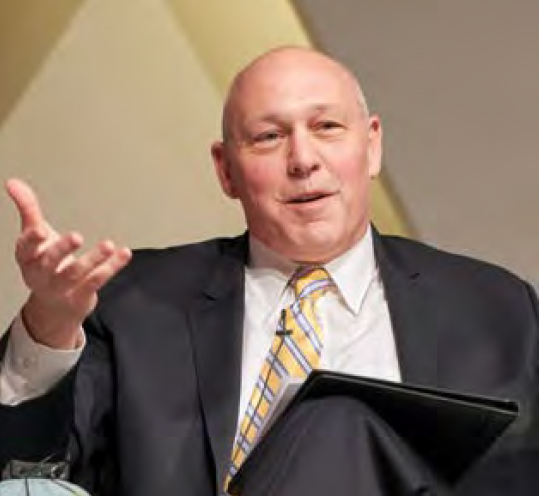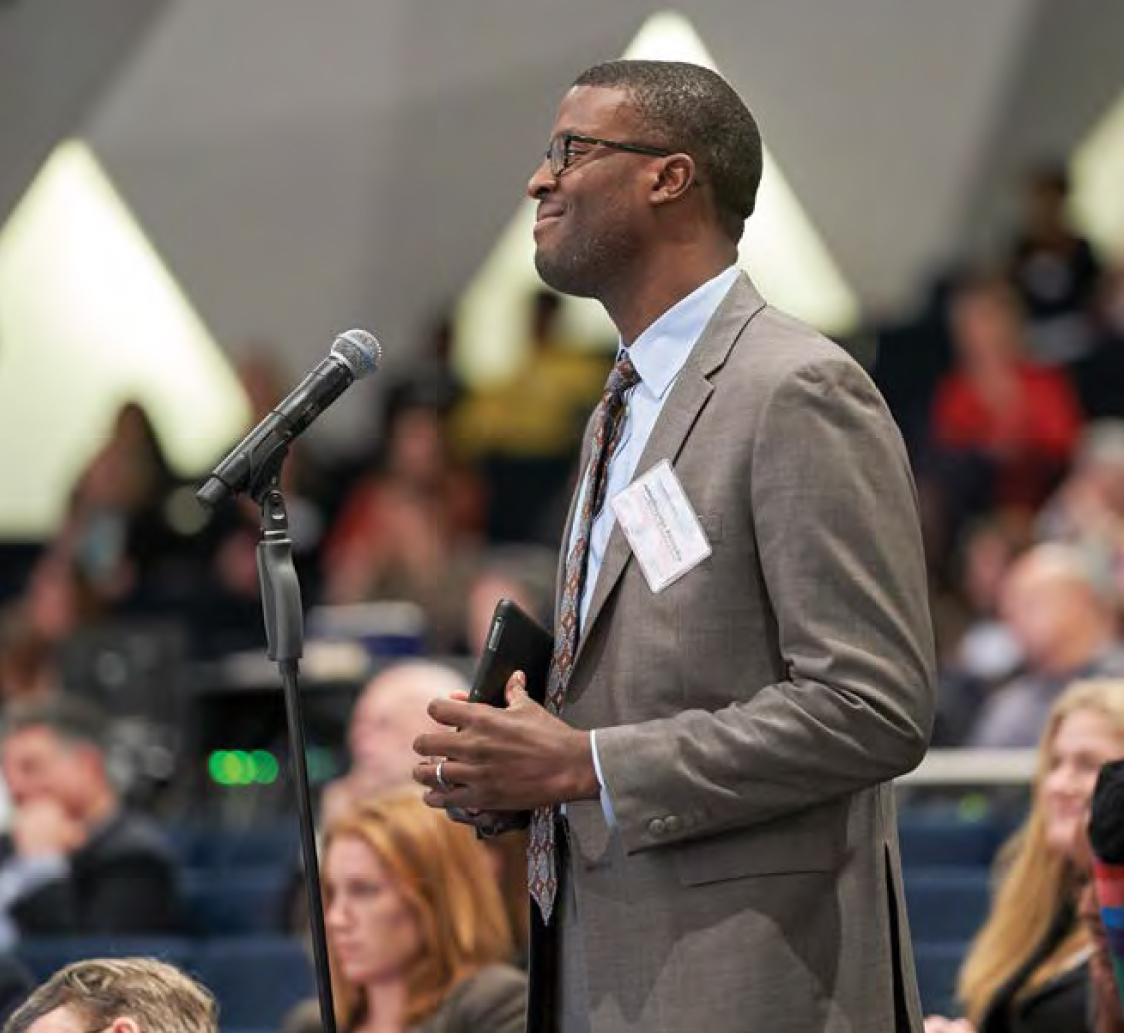6: THE EVOLUTION OF THE GOVERNMENT–UNIVERSITY RESEARCH PARTNERSHIP
As was noted throughout the symposium, the U.S. system of university-based research has changed substantially over the past 75 years. One of the five topics discussed by panels at the symposium was how the government–university partnership has evolved and whether further changes are needed in the future.
 Maintaining a Competitive Edge
Maintaining a Competitive Edge
Ronald Daniels, president of Johns Hopkins University (JHU), emphasized the continued importance of competition in choosing and funding research proposals. In other countries, political considerations rather than merit are often influential in determining the flow of research funds, “but we’ve been able to resist that, and I think that accounts for the great success of our country.” The government and JHU have succeeded in applying merit-based review even to the Applied Physics Laboratory, which is a classified defense research organization embedded within the university. Despite the constraints imposed by secrecy, funding decisions are made on the basis of competition, merit, and determinations of scientific rigor, Daniels said.
Kristen Baldwin, deputy director for strategic technology exploitation and protection at the U.S. Department of Defense (DOD), cited government funding of defense-related research as a “force multiplier.” Retaining this advantage, she said, depends on removing the barriers that make it more difficult to attract highly skilled and talented personnel into the research ecosystem, including defense-related research.

Karen Sayre/Eikon Photography

Chris Fall, director of the Office of Science at DOE, observed that DOE’s 17 national laboratories are “techno-economic engines as well as engines for discovery and for achieving scientific goals.” Although a portion of the work done by the national laboratories is focused on specific governmental missions, the laboratories have also developed extensive technology transfer operations. For example, former Secretary of Energy Rick Perry established DOE’s first chief commercialization officer to oversee technology transfer. This change in emphasis has been a major departure for the department, Fall noted. “We spent the first 70 years of the existence of the Department of Energy and its precursors not telling anybody what we did. This pivot to being open, being engaged in public–private partnerships, in tech transition, is a new thing.”
Carrie Wolinetz, director of the Office of Science Policy at the National Institutes of Health (NIH), pointed to the differing strategies of the intramural and extramural programs at NIH as an example of how Bush’s vision has evolved. Though the majority of NIH’s funding goes to colleges and universities, about 20 percent goes to an intramural program that conducts research largely on NIH’s campus. The interests of the intramural program overlap with those of the extramural research program, but its steady stream of funding provides an ability to move quickly; for
|
“…an opportunity for leveraging and co-sponsoring funding to make our funding go that much farther.” —Kristen Baldwin, Deputy Director for Strategic Technology Exploitation and Protection, U.S. Department of Defense |
example, in response to public health crises. The intramural program can also engage in high-risk, long-term, and potentially high-impact projects that would be difficult to do through the extramural cycle of grant funding, Wolinetz said.
 The Risks Posed by Espionage
The Risks Posed by Espionage
As other nations have developed strong research enterprises, a concern has emerged that they will engage in academic espionage to drain intellectual property from U.S. research institutions, which is an issue that did not exist at the time of the Bush report. JHU has taken a pragmatic approach to the problem, said Daniels. Maintaining the openness and transparency of science is a model that has helped uphold the quality of science. But in some key areas, intellectual property is being stolen, “and we’re not naïve about that,” he said. Where espionage poses threats, vigorous action is warranted to prevent the release of data and technologies. “There’s an obligation on the part of the university to be super vigilant in all those areas,” said Daniels. At the same time, science is not a zero-sum game. The United States will benefit from good science done by foreign researchers in this country or in other countries. Universities need to rigorously protect sensitive information—in partnership with other institutions and countries—while simultaneously considering the value of openness and collaboration.
Fall observed that DOE also thinks hard about this issue, particularly with regard to
its laboratories that work on technologies related to national security. Full disclosure about relationships and conflicts is an important tool, he said, as is the education of researchers about their responsibilities to protect intellectual property while pursuing commercial opportunities.
Wolinetz pointed to the distinction that has to be made between normal competitiveness and nefarious behavior. “Both are very real, and we need to pay attention to them.” At the same time, moving away from openness has risks, “and we can’t lose sight of that.”
Baldwin cited the need to develop and grow international partnerships with countries that share our values. DOD and other agencies have research funding programs that are open to international partners, she noted, which creates “an opportunity for leveraging and cosponsoring funding to make our funding go that much farther.” DOE similarly has programs and facilities that “are open on a competitive basis for open science to anyone from around the world,” said Fall.
As Daniels said, universities have an obligation to comply with federal law and with the policy expectations that undergird the law, but the conversation tends to be too limited. The fundamental concern is how to extend the successes of the past 75 years, not just how

Karen Sayre/Eikon Photography
to limit the seepage of intellectual property to other nations. In 1976, federal R&D funding represented about 1.1 percent of the U.S. GDP, while it now represents less than 0.7 percent, a more than 30 percent reduction. “Are we going to have the courage of our convictions to believe that we’re going to fund science at the level we need to ensure competitiveness? Ultimately, that’s equally if not more important than the seepage issue.”
On this point, Daniels noted that the number of students applying from abroad for undergraduate and graduate programs at U.S. colleges and universities has fallen sharply in recent years, even as the number is up in competitor countries. “To the extent that we indulge a nativist instinct around this issue, we’re ultimately impairing our capacity to get the best and brightest from within the country and from outside the country into our scientific enterprise and, ultimately, to keep them here to create the companies that will bring jobs and prosperity.”
 Does the Relationship Need to Change?
Does the Relationship Need to Change?
In response to a question about whether the university–government partnership established by Science, the Endless Frontier needs to change, Baldwin asked whether more strategic outcomes can be deliberately created through the existing partnership. For instance, universities see more of the research spectrum than do other research performers. “Is there a way that we can leverage that fact?” she asked. Similarly, can the existing partnership be extended to companies and other entities? Such a broadening of the partnership could expedite the transition from basic to applied research to products and services.
Daniels recommended applying the scientific method to how science is actually done. For example, are the current set of institutes and centers at NIH the best way to organize the biomedical research enterprise, or are different models needed, including models that are more conducive to interdisciplinary collaboration? How does philanthropy complement federal funding? When philanthropy leads to new directions and methods of research, should the federal funding system adopt and build on that success? “I’d love to see more critical evaluation of [the research system] with a view to being able to identify and then generalize the successes we’ve had.”
Fall observed that Bush’s plan did not foresee the diversity of agencies that have ended up funding science. “There’s a diversity of agencies, a diversity of perspectives, and that works really well—we don’t want to ruin that.” Similarly, Wolinetz cautioned against concentrating funding in the hands of relatively few people. “How do we leave room to make sure that new paradigm-shifting ideas are free to enter the system, that new people are free to enter the system, in a way that allows us to maintain all the things we love about the meritocracy and the competitiveness but doesn’t exclude new ideas?”
Wolinetz also called attention to graduate education, which she described as “an apprenticeship system that has been largely unchanged for centuries.” The power disparities in graduate training create vulnerabilities that bad actors in the system can abuse, and the effectiveness of advisers and mentors is difficult to measure and improve. Solutions could be both gradual and radical, she said. For example, training awards can be structured to ensure that students are safe and that high-quality mentoring and training take place. However, most graduate students supported by NIH are under research grants, which have far fewer requirements. This is an area, she said, where a fundamental rethinking of the partnership between government and universities could be warranted.

Karen Sayre/Eikon Photography





